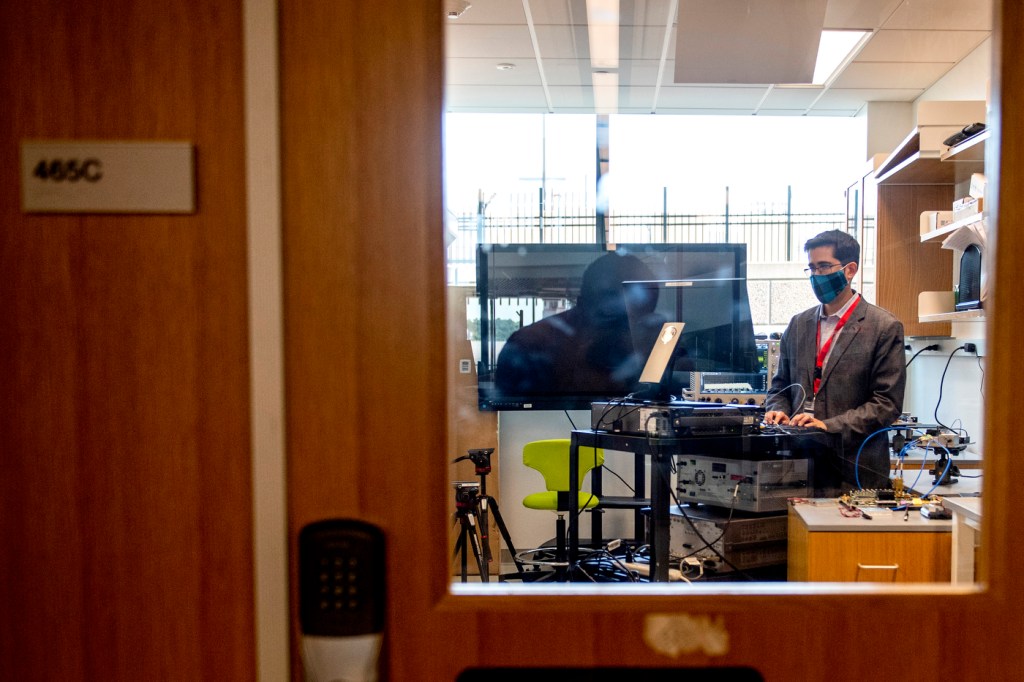A twisting vortex of laser light might solve our internet congestion woes

Earlier this year, millions of people moved to online working, studying, and socializing. Suddenly, the internet was eating up much more data than it was supposed to.
And it still is, because seven months later, many of us are still working, studying and, in general, living mostly on the internet.
The amount of pressure that we are putting on the existing networks is not small, and the internet is getting congested, says Josep Jornet, an associate professor of electrical and computer engineering at Northeastern.

Josep Jornet is an associate professor in the College of Engineering. Photo by Matthew Modoono/Northeastern University
At home, we’re sharing the same network with our family or roommates. Some people are trying to watch Netflix, others want to call grandpa on Zoom, and still others need to share large files for work—all simultaneously.
“Everyone is doing that at home, so imagine the amount of data that the internet has to handle locally, but then also nationally and internationally,” Jornet says. “We need to find ways to squeeze more data in the same infrastructure.”
Jornet was part of a team led by researchers at University of Pennsylvania that demonstrated a new way to manipulate lasers and tune the properties of their light in a way that could one day enable faster and better internet connections. They published their results in a recent study.
These days, pretty much everything that has to do with how the internet works is wired with optical fibers, where pulses of infrared light move data over long distances faster and more efficiently than electrical cables. Those flashes of light translate into binary code, which is transmitted in zeros and ones or, in the case of light, different intensities.
“To send zeros and ones, we need to manipulate a property of the signal that we’re sending,” Jornet says. “Because we’re dealing with optical communications, we are trying to manipulate a property of light.”


In recent decades, scientists and engineers have worked tirelessly to exploit and manipulate the properties of light to send more and more data. These properties include wavelength, amplitude, and polarization—all different characteristics of light at extremely microscopic scales.
In traditional optical communication systems, streams of data travel through optical fibers using different fluctuations of light waves, a method known as wavelength division multiplexing. The problem, Jornet says, is that those systems are getting overwhelmed as people use them for the kind of internet-based living the world has come to rely on.
Adding a new twist to the way that information travels creates many new ways to share data. That’s why Jornet’s team experimented with tiny lasers the size of computer chips to change properties of light that are harder to manipulate. The team specifically manipulated photons, particles that make up light, to produce vortex lasers at the nanoscale.
This type of nanotechnology emits lasers in spiral patterns, thanks to a tweak in their photons that gives them orbital angular momentum, which makes the light waves travel in a twirling pattern similar to the twists of a spiral staircase, or a very elongated piece of rotini pasta.
That ability to twist and tune light means that instead of sending a focused beam of light waves in a straight shot, like the lasers most of us are familiar with, the light of a vortex laser twists and spirals along its axis of travel. (In pasta terms, the light waves of a conventional laser would look like a straight piece of uncooked spaghetti.)
“We can twist clockwise or counterclockwise,” Jornet says. “Even when we’re twisting the light in the same direction, we can make the vertices be closer or farther, so we can twist with different angles.”
That’s important, Jornet says, because in theory, there are unlimited degrees in which scientists could manipulate the orbital angular momentum of photons to transmit data. And one of the biggest benefits of tuning those angles is that each different change to the mode of spiraling presents a new way to send data—and thus increase the capacity of a network—be it to watch Netflix, or work from home.
The idea of producing a vortex laser isn’t new. But until now, Jornet says, researchers had not been able to manipulate the exact shape and twists of the light as it is emitted from a tiny chip device. Generally, researchers had needed a lens or additional hardware.
Additionally, other approaches that used orbital angular momentum had only provided a way to control one mode of this property. That is, once researchers built a vortex laser, the orbital angular momentum of its photons was fixed, and it was nearly impossible to change it, Jornet says.
The new findings show that engineers can now work with a tunable microchip device that can switch orbital angular momentum modes dynamically, and at will.
“We just need to change the electrical conditions that we apply to it,” Jornet says. “We can apply a signal to the laser, and the laser based on that signal will change.”
Which means information sent with different orbital angular momentum won’t clog a network, or mix up with other data as it travels within the optical fiber. In other words, Jornet says, engineers could multiplex information, and send a lot of it at the same time, using the network systems that have already been built.
“Imagine that the photonics industry, the optical fiber industry, believes in this and realizes that it’s better to keep one optical fiber they already have in place, and only change what you connect at the end,” Jornet says. “You don’t need to install new infrastructure—you just need to change the transmitter and the receiver.”
Now that the team has shown how to tune the orbital angular momentum of light at the nanoscale, Jornet says the next step is figuring out how to design and build lasers that can do the same over long distances.
“We have demonstrated, designed, and built a laser that can manipulate a property of light, which we can then leverage to send information,” Jornet says. “We now understand the physics very well, so we just need to think better on how we can increase the distance it travels.”
For media inquiries, please contact media@northeastern.edu.





